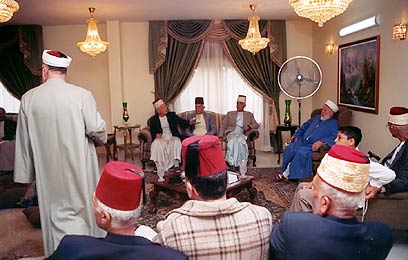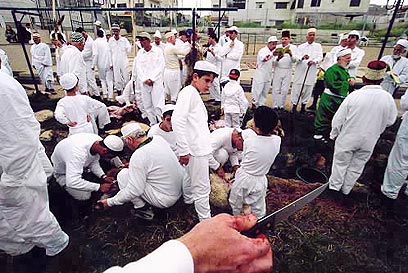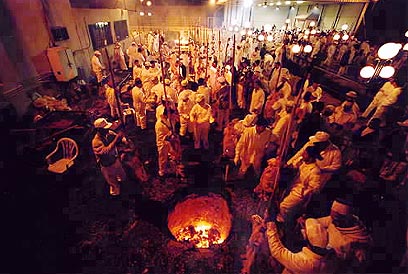A day before the Jewish Seder is held on the eve of the Passover holiday, the Samaritan community gathers on the holy Mount Gerizim in the West Bank to hold the their most important religious ceremony: the Passover sacrifice. Photographer Amnon Kfir documented the ceremony during which every family must sacrifice and eat a lamb
Amnon K'fir
| Published: | 05.02.07, 13:52 / Israel Travel |
Priests and community's elders in the traditional colorful garb next to a group of young men dressed in white overalls and baseball caps, all singing loudly, chanting prayers. The heat generated by dozens of fires is diluted by a cold breeze that spreads sparks through the night's air.

Samaritan community gathers for sacrifice ceremony
This is the setting for one of the least-known Pesach ceremonies: the Samaritan Passover sacrifice.
The Samaritans are an ethnic group that descended from the inhabitants of the ancient Samaria region. Yet their name is derived not from the geographical location but from the Hebrew verb "shamar" (keepers of the law).
The Samaritans claim that, as opposed to mainstream Judaism, theirs is the true religion of the ancient Israelites, predating the Jewish Temple in Jerusalem.
In 2005 there were about 700 Samaritans in Israel, living mostly on the holy Mount Gerizim near the city of Nablus in the West Bank.
Each year, a day before the Jewish Seder meal is held to mark the beginning of the Passover holiday, members of the Samaritan community gather, under tight security, in Kiryat Luza on Mount Gerizim to celebrate the traditional Passover sacrifice.

Samaritan elders congregate
In the afternoon, community representatives arrive at the home of the great priest to invite him to partake in the ceremony. The event begins with the chanting of prayers and verses from the book of Exodus, which tells the story of the Israelites journey from Egypt to the land of their fathers.

Elders during cermony
At precisely 7:10 pm, the great priest gives the signal to begin the sacrifice of dozens of sheep. Samaritan women are allowed to watch but not participate. Once all the sheep are killed, they are placed in deep holes - "ovens" - for about three hours.

Knives sharpened in preparation for sacrifice

Lambs skinned

Burning coals in "ovens" emit heat

Huge skewers go into the holes

Jute sacks cover the hole to ensure cooking
Close to midnight, each family takes its lamb home where it will be quickly eaten together with matzas and bitter herbs. The leftovers will be burned.
Amnon K'fir is an ethno-geographical photographer.



Leave a comment